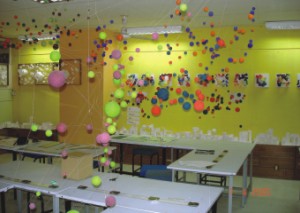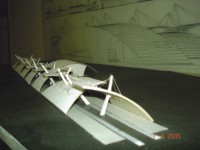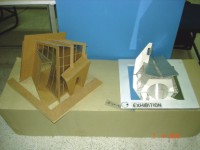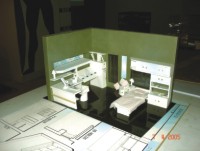|
Architecture
Building
for Future
Mustafa
Zaman
 It
was only in 2002 that the Department of Architecture of BRAC
University was established. Three years later, the prospect
for its future seems to be shining at its brightest. On the
opening day of the two-week-long exhibition, three floors
of the Standard Tower that house the faculty is dressed in
festivity. Designs had been laid out on the floors, which
make you hesitate while shifting your feet. Plan-sheets, cardboard
models and pattern-like exercises -- both two and tree dimensional
-- make up the exhibits that address ideas relating to form
and structure. The students are busy giving directions to
the visitors, leading them from one room to the other where
different projects are ready to take one by surprise. Amidst
the well-conceived designs, the students were not the only
source of youthful energy, the models for their dynamism and
novelty reflected their creators' vive. It
was only in 2002 that the Department of Architecture of BRAC
University was established. Three years later, the prospect
for its future seems to be shining at its brightest. On the
opening day of the two-week-long exhibition, three floors
of the Standard Tower that house the faculty is dressed in
festivity. Designs had been laid out on the floors, which
make you hesitate while shifting your feet. Plan-sheets, cardboard
models and pattern-like exercises -- both two and tree dimensional
-- make up the exhibits that address ideas relating to form
and structure. The students are busy giving directions to
the visitors, leading them from one room to the other where
different projects are ready to take one by surprise. Amidst
the well-conceived designs, the students were not the only
source of youthful energy, the models for their dynamism and
novelty reflected their creators' vive.
Any architecture
faculty is a hub where creativity meets functionality. The
faculty of BRAC University is no exception. The designs are
proof of that. Faria Tasnin, a third year student, testifies
that they draw their inspiration from varied sources. "We
study works by major architects, the major iconic achievements
that dot the planet. During study, the students are given
assignments to replicate residential houses by major modern
architects like Frank Lloyd Write, Le Corbusier and Peter
Eisenman. Even the works by major Bangladeshi exponents are
replicated and studied," says Faria.
 Any
miniaturised building gives out a kind of mystic delight.
This very effect gets even augmented when precision comes
into play. At the show, most creative models draw their inspiration
from many sources. Modernism, as usual, is unavoidable for
any learner as functionality and form are still the mainstay
in the architectural vocabulary. But the display of replicas
of Ahsan Manzil as well as buildings dating back to the European
Renaissance reveals a strong sensitivity to the past. Any
miniaturised building gives out a kind of mystic delight.
This very effect gets even augmented when precision comes
into play. At the show, most creative models draw their inspiration
from many sources. Modernism, as usual, is unavoidable for
any learner as functionality and form are still the mainstay
in the architectural vocabulary. But the display of replicas
of Ahsan Manzil as well as buildings dating back to the European
Renaissance reveals a strong sensitivity to the past.
In different
stages students go through different exercises. The show encapsulates
most of their assignments that they had to do last year. The
project of cultural centre was the work of the students of
third year. "The exhibition is one way of appraising
our works as well as getting feedback," believes Faria.
"We are supposed to organise this exhibition once every
year. However, since 2002, we have managed to do it thrice,"
relates Fuad H Mallik, Chairman of the faculty.
These
are "school projects" that even tackle issues concerning
urban development while embracing a wide range of subjects.
From railway station, to pedestrian walkway, to urban planning,
the exhibits touch upon everything relating to modern living.
One of the  most
interesting aspects of these works lies in the fact that the
very location of the faculty has been given a thought in one
particular project. One of the participants, Samira Islam,
a fourth year student, had on display the plans for rearranging
their own area, which she terms as a mixed one. "The
Cancer Centre doesn't fit into the scene. We have shown that
for a hospital you need to have a surrounding suitable for
the patients," she emphasised. Her project incorporates
a community centre, supermarket, gymnasium and a food court
to address the needs of the locality. most
interesting aspects of these works lies in the fact that the
very location of the faculty has been given a thought in one
particular project. One of the participants, Samira Islam,
a fourth year student, had on display the plans for rearranging
their own area, which she terms as a mixed one. "The
Cancer Centre doesn't fit into the scene. We have shown that
for a hospital you need to have a surrounding suitable for
the patients," she emphasised. Her project incorporates
a community centre, supermarket, gymnasium and a food court
to address the needs of the locality.
Aother
project by fourth year students is the Benarashi Pallee at
Mirpur. "On the CRP proposed land we have designed a
vast area of low-cost housing with the view to relocate the
weavers. The project comprises all -- their workplace, health
and educational facilities as well as banks, post office and
even basic training centres," says Samira.
As for
the creative zeal that had poured out in the students' efforts
to build resort or community centres, railway stations or
plain exercises in constructing and deconstructing forms,
the "Exhibition 2005" at Standard Tower in Banani
provides an opportunity to recognise new talents.
 The
members of the faculty display both their resolve and experimental
inclination by devising a new way of communicating their message.
For them a colourful paper-cube become substitute for the
conventional leaflet. "We try to keep in touch with the
world. There are programmes that we designed to expose the
students to present-day development and ideas. Both the famous
and the young architects of Dhaka are often invited to deliver
talks," says Fuad Mallick. On April 12, the faculty even
arranged for a day-long discussion meeting with the parents
of their recruits to "bring to light the objectives and
philosophies behind architecture as well as education in this
field." The
members of the faculty display both their resolve and experimental
inclination by devising a new way of communicating their message.
For them a colourful paper-cube become substitute for the
conventional leaflet. "We try to keep in touch with the
world. There are programmes that we designed to expose the
students to present-day development and ideas. Both the famous
and the young architects of Dhaka are often invited to deliver
talks," says Fuad Mallick. On April 12, the faculty even
arranged for a day-long discussion meeting with the parents
of their recruits to "bring to light the objectives and
philosophies behind architecture as well as education in this
field."
The show
began on April 7 and continued till April 21. Those who went
to look at it came back with a renewed hope in designing and
building with responsibility and style. This country surely
is in dire need of both.
Photo:
Imran H Khan
Copyright
(R) thedailystar.net 2005
| 